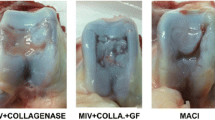Summary
Partial and full thickness defects were created mechanically in articular cartilage and subchondral bone of the tibiotarsal joint condyles of 3-year-old chickens. The wounds were then repaired using embryonal chick chondrocytes embedded in a new biocompatible, hyaluronic acid-based delivery substance. Controls were similarly operated on but received either no treatment or implants of the delivery substance only. Animals were killed from 1 week to 6 months postoperatively. Sections from the two groups were examined and compared macroscopically, histologically, and histochemically. Results of 6-month follow-up showed that only the defects of the experimental chickens were completely filled with reparative hyaline cartilage tissue, with no signs of inflammation or immunologic rejection. Initially the entire defect cavity, whether partial thickness or full thickness up to the deep regions in the subchondral bone, was filled with cartilaginous reparative tissue. Relatively rapid maturation occurred under the tidemark; chondrocytes hypertrophied, were invaded with vascular elements and ossified. In the superficial areas, the reparative tissue remained cartilaginous and matured as typical hyaline cartilage tissue. These results indicate that aged chicken cartilage and its accompanying thin and spongy osteoporotic bone offer a favorable host environment for embryonal cell implants.
Similar content being viewed by others
References
Campbell CJ (1969) The healing of cartilage defects. Clin Orthop 64:45–53
Ghadially FN (1983) Fine structure of synovial joints. Butterworths, London, pp 261–307
Mitchell N, Shepard N (1976) The resurfacing of adult rabbit articular cartilage by multiple perforations through the subchondral bone. J Bone Joint Surg 58A:230–233
Furukawa T, Eyre DR, Koide S, Glimcher MJ (1980) Biochemical studies on repair cartilage resurfacing experimental defects in the rabbit knee. J Bone Joint Surg 62A:79–89
Bentley G, Greci RB (1971) Homotransplantation of isolated epiphyseal and articular cartilage chondrocytes into joint surfaces of rabbits. Nature 230:385–388
Bentley G, Smith AV, Mukerjhee R (1978) Isolated epiphyseal chondrocyte allograft into joint surface—an experimental study in rabbits. Ann Rheum Dis 37:449–458
Aston JE, Bentley G (1986) Repair of articular surfaces by allografts of articular and growth plate cartilage. J Bone Joint Surg 68B:29–34
Itay S, Abramovici A, Nevo Z (1987) Use of cultured embryonal chick epiphyseal chondrocytes as grafts for defects in chick articular cartilage. Clin Orthop 220:284–303
Dustman HO, Puhl W (1976) Alterabhangige Heilungsmoglichkeiten von Knorpelwunden. Z Orthop 114:749–764
Vignon E, Arlot M, Patricot LM, Vignon G (1976) The cell density of human femoral head cartilage. Clin Orthop 121:303–308
Engkvist O (1979) Reconstruction of patellar articular cartilage with free autologous perichondral grafts. Scand J Plast Reconstr Surg 13:361–369
Kon M (1981) Cartilage formation from perichondrium in a weight-bearing joint. Eur Surg Res 13:387–396
O'Driscoll SW, Salter RB (1986) The induction of neochondrogenesis in free intra-articular periosteal autografts under the influence of continuous passive motion. J Bone Joint Surg 66A:1248–1257
O'Driscoll SW, Salter RB (1986) The repair of major osteochondral defects in joint surfaces by neochondrogenesis with autogenous osteoperiosteal grafts stimulated by continuous passive motion. Clin Orthop 208:131–140
Rubak JM (1982) Reconstruction of articular cartilage defects with free periosteal grafts. Acta Orthop Scand 53:175–180
Elves MW (1974) A study of the transplantation antigens on chondrocytes from articular cartilage. J Bone Joint Surg 56B:178–185
Heyner S (1969) The significance of the intercellular matrix in the survival of cartilage allografts. Transplantation 8:666–676
Plenk H, Passi R (1981) Trans-and replantation of articular cartilage using the fibrinogen adhesive system. In: Gastpar H (ed) Biology of the articular cartilage in health and disease. Proceedings of the 2nd Munich Symposium on Biology of Connective Tissue. Schattauer, Stuttgart, New York
Author information
Authors and Affiliations
Rights and permissions
About this article
Cite this article
Robinson, D., Halperin, N. & Nevo, Z. Regenerating hyaline cartilage in articular defects of old chickens using implants of embryonal chick chondrocytes embedded in a new natural delivery substance. Calcif Tissue Int 46, 246–253 (1990). https://doi.org/10.1007/BF02555003
Received:
Revised:
Issue Date:
DOI: https://doi.org/10.1007/BF02555003




